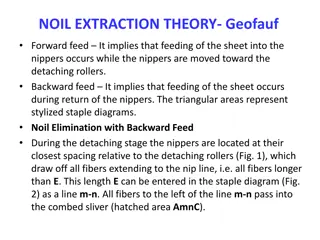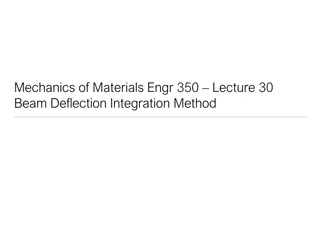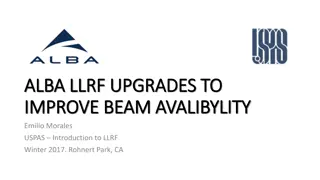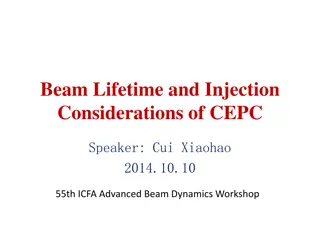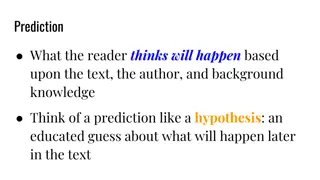Phase Feed Forward System: Analyzing Beam Phase Stability and Theoretical Predictions
Exploring the impact of phase feed forward systems on beam phase stability through comparisons with theoretical predictions and simulations of increasing limitations. Testing the accuracy of theoretical gain factors and assessing performance using global gain factors. Utilizing specific data files and equations to evaluate the effectiveness of the feed forward system.
Download Presentation

Please find below an Image/Link to download the presentation.
The content on the website is provided AS IS for your information and personal use only. It may not be sold, licensed, or shared on other websites without obtaining consent from the author.If you encounter any issues during the download, it is possible that the publisher has removed the file from their server.
You are allowed to download the files provided on this website for personal or commercial use, subject to the condition that they are used lawfully. All files are the property of their respective owners.
The content on the website is provided AS IS for your information and personal use only. It may not be sold, licensed, or shared on other websites without obtaining consent from the author.
E N D
Presentation Transcript
1 CTF3: Phase Feed Forward System. Murtaza Safdari CTF3: PHASE FEED FORWARD Comparing the effect of the phase feed forward system on beam phase stability with various theoretical predictions.
2 CTF3: Phase Feed Forward System. Murtaza Safdari Why compare with simulations? Our real phase feed forward system is naturally limited by the equipment and physical limits of the correction process. In light of this fact, we shall compare the real feed forward system with increasingly limited simulations, to study which limitation impacts the feed forward system the most, and how close the system comes to its theoretical performance. The order of increasing limitation on the simulations is as follows: Point by point correction with no limits Global gain correction with no limit Global gain restricted to +/-2 degrees (or +/-2.5) Global gain with time offsets. Global gain restricted to 30MHz (or 50MHz) bandwidth
3 CTF3: Phase Feed Forward System. Murtaza Safdari A foreword about the data files used The analysis was done using the following two sets of data files: 20150703_1855_R56_0.15.mat 20150703_1843_R56_0.3.mat 20150703_1842_R56_0.2.mat 20150703_1841_R56_0.1.mat 20150703_1840_R56_0.0.mat 20150707_2037_FFGain_63_Interleaved_Even(Odd).mat 20150707_2052_FFGain_53_Interleaved_Even(Odd).mat 20150707_2102_FFGain_43_Interleaved_Even(Odd).mat 20150707_2138_FFGain_43_Interleaved_Even(Odd).mat 20150707_2123_FFGain_33_Interleaved_Even(Odd).mat
4 CTF3: Phase Feed Forward System. Murtaza Safdari Testing the Theoretical Gain The first step in assessing the performance of the feed forward system, is to assess the accuracy of the theory used to gauge its performance. The optimal gain factor is given by the following equation: Optimal Gain = Correlation between upstream and downstream phases * (ratio of the standard deviation of the phase downstream to that of the same upstream) And so, using the R56.x files, A comparison between this theoretical gain and the best possible gain factor given the data was done.
5 CTF3: Phase Feed Forward System. Murtaza Safdari Using Global Gain Factors The first approach makes use of one global factor over the entire length of the pulse. This is also how the actual feed forward system works, and so this is where we begin. To simulate the downstream phase after the correction is applied, we simply subtract from the downstream phase the upstream phase multiplied by the appropriate gain factor. We do this for every pulse, as we traverse the sample range. After this, we take a mean over all of the pulses to get the mean phase, and take the standard deviation over all the pulses to get the jitter values. In our initial analysis, we compare the performance of the theoretical best gain, with that of a gain optimized to reduce the jitter.
6 CTF3: Phase Feed Forward System. Murtaza Safdari R56 0.2
7 CTF3: Phase Feed Forward System. Murtaza Safdari In Summary File Name Theoretical Gain 1.1309 1.6458 1.594 1.5343 1.0189 Optimized Gain 1.2943 1.2823 1.3624 1.046 .98999 Theoretical Best Jitter* 2.8958 2.0938 .7559 .9871 1.9275 Optimized Best Jitter* 2.8945 2.0852 .7450 .9484 1.9275 R56 0.0 R56 0.1 R56 0.15 R56 0.2 R56 0.3 Minima of the Jitter VS Gain plots *The Jitters above are the mean Jitters in the sample range.
8 CTF3: Phase Feed Forward System. Murtaza Safdari Using Variable Gains In this method, the gain varied point by point along every pulse. This is then compared to the best Theoretical prediction, which is also found at every point. Since this isn t exactly what the feed forward does, this part of the analysis gives an idea of the best possible correction that can be applied. In this way, this is representative of just how good a feedforward system could possibly get, given the beam parameters (correlations in phases, etc.). The same files as the Global Gain assessment are used here.
9 CTF3: Phase Feed Forward System. Murtaza Safdari R56 0.2
10 CTF3: Phase Feed Forward System. Murtaza Safdari Point by Point VS Global Gain Having studied the theoretical corrections involving both, point by point optimal theoretical corrections and global theoretically best corrections, we can now compare the impact of the two processes on the downstream phases. File Point By Point Global R56 0.0 Downstream Jitter 2.8830 Mean Phase 0.7662 R56 0.1 Downstream Jitter 2.0791 Mean Phase 0.2486 R56 .15 Downstream Jitter 0.7283 Mean Phase -0.1951 R56 0.2 Downstream Jitter 0.9458 Mean Phase 0.0580 R56 0.3 Downstream Jitter 1.9136 Mean Phase -0.8753 2.8958 -0.0268 2.0938 -0.0527 0.7559 -0.0371 0.9871 -2.7620e-15 1.9275 -5.9573e-16 *looking in sample range, after applying subtractPhase.
11 CTF3: Phase Feed Forward System. Murtaza Safdari A Note on the gain expressions At this point, I slightly change my expression for the best theoretical gain factor, from the previously used: TheMaxGain=(corrMeanMix2Mix3).*(.meanStdPhaseAlongPuls e(3))/(meanStdPhaseAlongPulse(2)); To the now used: meanGain = corrMeanMix2Mix3*(stdMeanPulsePhase(3)/stdMeanPulsePha se(2)) The difference between the two is small, but the later expression is better. The sample by sample stats typically have a larger jitter ratio but lower correlation than the stats calculated on the mean phase. The issue with TheMaxGain equation is that we use the sample by sample jitter but the mean correlation, so it's like high ratio*high correlation. This means is that all the global gain results presented so far are slightly over-correcting compared to optimal.
12 CTF3: Phase Feed Forward System. Murtaza Safdari Comparing Theory with the Feed Forward System Having verified the theory, it is now possible to make an assessment of the Feed Forward system s performance. In addition to the Simulated Gain (Theoretical Gain), we will also be comparing against the known Simulated Feed Forward Gain (which in our case is the file name Gain * .0252). Files used: 20150707_2037_FFGain_63_Interleaved_Even(Odd).mat 20150707_2052_FFGain_53_Interleaved_Even(Odd).mat 20150707_2102_FFGain_43_Interleaved_Even(Odd).mat 20150707_2138_FFGain_43_Interleaved_Even(Odd).mat -> 43 (2) 20150707_2123_FFGain_33_Interleaved_Even(Odd).mat
13 CTF3: Phase Feed Forward System. Murtaza Safdari Origins of the FF Gain formula The Real (theoretical) Gain factor achieved by the FF system, R ? = ???? R Real applied Gain g Gain set in FONT5 DAQ (-63 to +63) A Phase calibration constant as calculated on FONT5 board (90.14) k Radians kick per count on FONT5 DAC output (1/2.86 e4) c Constant in firmware (8) ??? 0.02523
14 CTF3: Phase Feed Forward System. Murtaza Safdari The Optimal Gain in FONT5 units It is now possible to get an expression for the optimal gain, in the FONT5 units. This follows from the realization that ??? is the required conversion ratio. ???? = ??????????? ?????? ????? / ??? (i.e., ???? = ??????????? ?????? ?????/0.02523) (typical values of 0.8 correlation, 1.3 downstream jitter and 0.9 upstream jitter for these files gives an optimal "file" gain of about 46.)
15 CTF3: Phase Feed Forward System. Murtaza Safdari A note on procedure used The interleaved files have data with both, the feed forward system turned on, as well as the system turned off. We use the data in the FF off files to simulate the corrections and corrected phase and jitter values, and compare them with the values from the FF on files. This thus enables us to perform the first true assessments of the FF performance.
16 CTF3: Phase Feed Forward System. Murtaza Safdari Gain 53
17 CTF3: Phase Feed Forward System. Murtaza Safdari In Summary File Gai n Initial Jitter down stream Jitter after theoreti cal correcti on Jitter after simulat ed Feed Forwar d Gain Jitter after real Feed Forwar d Gain Simula ted Gain Simulat ed Feed Forwar d Gain Upstrea m Jitter Feed Forwar d System Off Upstrea m Jitter - Feed Forwar d System On Correlat ion betwee n Up and Downst ream Phase. 0.8997 63 1.3793 0.8045 0.8882 0.9679 1.2059 1.5876 0.9367 0.9027 53 1.2684 0.8579 0.8857 0.9480 1.0928 1.3356 0.8545 0.9277 0.8574 43 2.1805 1.4313 1.4700 1.6105 0.8758 4 1.0168 1.0836 1.8509 1.9037 0.8107 43 (2) 33 1.1111 0.7849 0.7879 0.7703 1.0836 0.7865 0.8037 0.8325 1.6656 0.9926 1.0041 1.3668 1.1091 0.8316 1.1496 1.1735 0.8539 It is clear that the feed forward, while improving the downstream jitter, is not achieving its full potential. Further analyses which will include the theoretical predictions limited by the physical limitations of the system will serve as a truer benchmark to compare the feed forward system with.
18 CTF3: Phase Feed Forward System. Murtaza Safdari Restricted Global Gain Simulations (+/- 2 degrees) We now restrict the magnitude of our applied theoretical corrections to the phase to a small window of +/- 2 degrees. We allow the centre of this window to vary slightly as we try to find the simulation which most closely matches the real FF system, or which minimizes the Jitter downstream. Along with the Phase and Jitter plots after these correction, plots for the fraction of pulses included in each window at every sample point, as well as both global and point by point theoretical gains are also included for a better understanding of the data. The reason we simulate data with limited corrections is to more closely match the real FF system, and in this way assess just how much of a difference this makes on the overall performance of the F system.
19 CTF3: Phase Feed Forward System. Murtaza Safdari Gain 53, +/- 2 degrees
20 CTF3: Phase Feed Forward System. Murtaza Safdari Gain 53, Gains
21 CTF3: Phase Feed Forward System. Murtaza Safdari Gain 53, Mean Pulse Phase
22 CTF3: Phase Feed Forward System. Murtaza Safdari Tables of key parameters (+/- 2 deg) Gain Jitter after FF system Initial Jitter Jitter after unlimited correction Minimized Jitter (mean of window) Jitter after min deviation to real FF (mean) Jitter after min Jitter Deviation from real FF (mean) Flatness upon minimizing the Jitter Flatness upon minimizing the deviation to FF 63 0.9679 1.3793 0.8045 0.9589 (.5) 0.9734 (0) 0.9734 (0) 0.9756 0.8891 53 0.9480 1.2684 0.8579 0.9511 (.5) 0.9561 (0) 0.9561 (0) 0.9813 0.8938 43 1.6105 2.1805 1.4313 1.5125 (.5) 1.5125 (.5) 1.5830 (-.5) 1.2023 1.2023 43(2) 0.7703 1.1111 0.7849 0.8400 (0) 0.8408 (-.5) 0.8620 (-1) 1.1271 1.1065 33 1.3668 1.6656 0.9926 1.1344 (.5) 1.1344 (.5) 1.1740 (-1) 1.1841 1.1841 The minimum deviation is found by minimizing the mean of the square of the difference between the phase values, in the sampleRange.
23 CTF3: Phase Feed Forward System. Murtaza Safdari Jitters on Mean Pulse Phases (+/- 2 degrees) Gain Initial Real FF Global Theoretic al Gain Point by Point Theoretic al Gain Upon minimizin g Jitter Upon minimizin g Deviation to real FF phases Upon minimizin g Deviation to real FF Jitters 63 53 43 43 (2) 33 The Jitters here are the jitters in the Mean Pulse Plots. The Mean Pulse Phase plots were formed by taking the mean of the phases for each pulse within the sample range. 1.2318 1.0665 1.9855 0.9388 1.4510 0.6944 0.6383 1.3224 0.5621 1.1083 0.5376 0.5488 1.1654 0.5200 0.7063 0.5380 0.5480 1.1639 0.5189 0.7065 0.6509 0.6113 1.2394 0.5584 0.8582 0.6750 0.6276 1.2394 0.5737 0.8582 0.6750 0.6276 1.3248 0.6046 0.8647
24 CTF3: Phase Feed Forward System. Murtaza Safdari In Summary First of all we note that, under the conditions where the corrections are limited to +/- 2 degrees, and by allowing the mean of our acceptance window to walk about a little bit, the best theoretical jitter produced was often slightly worse, or close to the real FF system. This thus represents a notable limitation of the FF system. This now warrants an investigation into trying the same out with a bigger window, like +/- 2.5 or 4 degrees. Moving now onto +/- 2.5 degrees
25 CTF3: Phase Feed Forward System. Murtaza Safdari Gain 53, +/- 2.5 degrees
26 CTF3: Phase Feed Forward System. Murtaza Safdari Tables of key parameters (+/-2.5 deg) Gain Jitter after FF system Initial Jitter Minimized Jitter after unlimited correction Minimized Jitter (mean of window) Jitter after min deviation to real FF phase (mean) Jitter after min Jitter Deviation from real FF (mean) Flatness upon minimizing the Jitter Flatness upon minimizing the deviation to FF 63 0.9679 1.3793 0.8045 0.9136 (.5) 0.9136 (.5) 0.9324 (-.5) 0.8028 0.8028 53 0.9480 1.2684 0.8579 0.9190 (0) 0.9345 (1) 0.9190 (0) 0.7457 0.9513 43 1.6105 2.1805 1.4313 1.4405 (.5) 1.4465 (1) 1.5420 (-1) 1.0567 1.1852 43(2) 0.7703 1.1111 0.7849 0.8107 (-.5) 0.8590 (1) 0.8152 (-1) 0.9597 1.2011 33 1.3668 1.6656 0.9926 1.0851 (0) 1.1177 (1) 1.1074 (-1) 0.9589 1.1581 The minimum deviation is found by minimizing the mean of the square of the difference between the phase values, in the sampleRange.
27 CTF3: Phase Feed Forward System. Murtaza Safdari Jitters on Mean Pulse Phases (+/- 2.5 degrees) Gain Initial Real FF Global Theoretic al Gain Point by Point Theoretic al Gain Upon minimizin g Jitter Upon minimizin g Deviation to real FF phases Upon minimizin g Deviation to real FF Jitters 63 53 43 43 (2) 33 The Jitters here are the jitters in the Mean Pulse Plots. The Mean Pulse Phase plots were formed by taking the mean of the phases for each pulse within the sample range. 1.2318 1.0665 1.9855 0.9388 1.4510 0.6944 0.6383 1.3224 0.5621 1.1083 0.5376 0.5488 1.1654 0.5200 0.7063 0.5380 0.5480 1.1639 0.5189 0.7065 0.5983 0.5844 1.1601 0.5384 0.7886 0.5983 0.5840 1.1645 0.5544 0.8313 0.6321 0.5844 1.2822 0.5503 0.7941
28 CTF3: Phase Feed Forward System. Murtaza Safdari Gain 53 with +/- 4 degrees
29 CTF3: Phase Feed Forward System. Murtaza Safdari Gain 53, Mean Pulse Phase
30 CTF3: Phase Feed Forward System. Murtaza Safdari Comparisons of different windows Gain Jitter after FF syste m Initial Jitter Jitter after unlimi ted correc tion (Point By Point gain) Jitter after unlimi ted correc tion Minimi zed Jitter (+/- 2 deg) Jitter after min Deviat ion from FF syste m (+/- 2 deg) Jitter after min JitterD eviatio n from FF syste m (+/- 2 deg) Minimi zed Jitter (+/- 2.5 deg) Jitter after min Deviat ion from FF syste m (+/- 2.5 deg) Jitter after min JitterD eviatio n from FF syste m (+/- 2.5 deg) Minimi zed Jitter (+/- 4 deg) Jitter after min Deviat ion from FF syste m (+/- 4 deg) Jitter after min JitterD eviatio n from FF syste m (+/- 4 deg) 63 0.967 9 1.379 3 0.800 4 0.804 5 0.958 9 0.973 4 0.973 4 0.598 3 0.598 3 0.632 1 0.818 7 0.853 5 0.853 5 53 0.948 0 1.268 4 0.855 7 0.857 9 0.951 1 0.956 1 0.956 1 0.584 4 0.584 0 0.584 4 0.861 2 0.885 7 0.885 7 43 1.610 5 2.180 5 1.390 5 1.431 3 1.512 5 1.512 5 1.583 0 1.160 1 1.164 5 1.282 2 1.321 8 1.333 6 1.363 3 43 (2) 0.770 3 1.111 1 0.771 4 0.784 9 0.840 0 0.840 8 0.862 0 0.538 4 0.554 4 0.550 3 0.785 9 0.812 0 0.785 9 33 1.366 8 1.665 6 0.989 2 0.992 6 1.134 4 1.134 4 1.174 0 0.788 6 0.831 3 0.794 1 0.992 6 1.058 7 1.058 7
31 CTF3: Phase Feed Forward System. Murtaza Safdari Comparisons of different windows (Jitters on Mean Pulse Phase) Gain Initia l Real FF Globa l Theor y Point by Point Theor y Upon mini mizin g Jitter (2deg ) Upon mini mizin g Devia tion to real FF phase s (2deg ) Upon mini mizin g Devia tion to real FF Jitter s (2deg ) Upon mini mizin g Jitter (2.5de g) Upon mini mizin g Devia tion to real FF phase s (2.5de g) Upon mini mizin g Devia tion to real FF Jitter s (2.5de g) Upon mini mizin g Jitter (4deg ) Upon mini mizin g Devia tion to real FF phase s (4deg ) Upon mini mizin g Devia tion to real FF Jitter s (4deg ) 63 1.23 18 0.69 44 0.53 76 0.53 80 0.65 09 0.67 50 0.67 50 0.58 47 0.58 47 0.62 81 0.53 87 0.55 33 0.55 33 53 1.06 65 0.63 83 0.54 88 0.54 80 0.61 13 0.62 76 0.62 76 0.57 05 0.56 81 0.59 82 0.55 09 0.55 37 0.55 37 43 1.98 55 1.32 24 1.16 54 1.16 39 1.23 94 1.23 94 1.32 48 1.13 17 1.13 30 1.26 46 1.03 80 1.05 33 1.07 92 43(2) 0.93 88 0.56 21 0.52 00 0.51 89 0.55 84 0.57 37 0.60 46 0.53 84 0.55 44 0.55 03 0.52 13 0.53 13 0.52 13 33 1.45 10 1.10 83 0.70 63 0.70 65 0.85 82 0.85 82 0.86 47 0.78 01 0.82 08 0.78 42 0.70 85 0.74 64 0.74 64
32 CTF3: Phase Feed Forward System. Murtaza Safdari Conclusions Theoretical optimal gain values (global and point by point) seem plausible, as the optimized gains are very close to the theoretical gains. Lowest jitter in any of the simulations is about 0.5 degrees; Shows that the beam conditions still need to be improved to achieve 0.2 degrees point by point jitter. +/-2 or +/-2.5 window simulations seem to give very close results to the real feedforward system. With +/- 4 window (i.e. when we have double the power from the amplifier), expect roughly 0.1 degrees reduction in the jitter we can achieve with the feedforward system.
33 CTF3: Phase Feed Forward System. Murtaza Safdari Restricted Correction, Differing window sizes We now analyze the files with variable window spans, and plot the jitters and phases for the cases in which the mean of the window minimizes the jitter in the sample range. We also plot some interesting properties across all the files for different window sizes.
34 CTF3: Phase Feed Forward System. Murtaza Safdari Gain 53
35 CTF3: Phase Feed Forward System. Murtaza Safdari Fraction Of Pulses
36 CTF3: Phase Feed Forward System. Murtaza Safdari Minimized Jitter in Range The dotted lines correspond to the jitter achieved by unrestricted global correction.
37 CTF3: Phase Feed Forward System. Murtaza Safdari Jitter on Mean Pulse Phase (upon minimizing the mean jitter)
38 CTF3: Phase Feed Forward System. Murtaza Safdari Phase in Range (upon min jitter)
39 CTF3: Phase Feed Forward System. Murtaza Safdari Shifting the relative time ordering The next step in our analysis takes us on a side road. We will now look into the time ordering of the downstream and upstream phases, and investigate whether the time ordering in the datafiles offers the highest correlations, and also investigate its effects on the jitters, especially after applying the optimal theoretical correction. The optimal theoretical correction depends on the correlations on the meanPulsePhase s up and down stream, whereas the time ordering is optimised using the correlations on the meanPhaseAlongPulse s, which makes sense, as the time variable is the sample number.
40 CTF3: Phase Feed Forward System. Murtaza Safdari Preliminary Analysis File Gain Initial Jitter down stream Jitter after theoretical correction (DataFile) Jitter after theoretical correlation (Optimised correlation ) (peak lag) 0.8015 (1) 0.8539 (2) 1.4286 (1) 0.7842 (1) 0.9855 (3) Jitter after real Feed Forward Gain Optimised Correlatio n on mean phase along pulse (peak lag) 0.9836 (1) 0.9808 (1) 0.9881 (1) 0.9744 (1) 0.9726 (1) DataFile Correlatio n on mean phase along pulse Optimised Correlatio n (Sample by Sample) (peak lag) DataFile Correlatio n (Sample by Sample) 63 1.3793 0.8045 0.9679 0.9716 0.8129 (1) 0.7361 (2) 0.7439 (2) 0.7111 (1) 0.7633 (3) 0.8112 53 1.2684 0.8579 0.9480 0.9686 0.7327 43 2.1805 1.4313 1.6105 0.9783 0.7426 43 (2) 1.1111 0.7849 0.7703 0.9635 0.7106 33 1.6656 0.9926 1.3668 0.9637 0.7593
41 CTF3: Phase Feed Forward System. Murtaza Safdari Gain 53
42 CTF3: Phase Feed Forward System. Murtaza Safdari A few points It is apparent that the minimized Jitters and the optimal correlations in the mean phase along pulse data happen quite close to the 0 lag point. The introduction of lags, although apparently make a difference when it comes to numerical values, doesn t make an appreciable difference when it comes to the actual magnitudes of the differences thence obtained. The shape of the gain vs lag plot is quite consistent with the mean phase along pulse plots for the respective files, in its nature in and around the sample range. The flatness of the correlations sample by sample, suggest that the effect of the passage of time is just to shift the shape of the pulse up or down in degrees, like a shift in the mean, as opposed to actually changing its shape. However, this could also just be an artifact of the flatness of the phase in the range of the pulse; as it s pretty flat to begin with, the passage of time couldn t possible change its shape much, for it to be a noticeable effect.
43 CTF3: Phase Feed Forward System. Murtaza Safdari Investigating Jitters and shapes Gain Upstream Mean Jitter in range Upstream Mean Jitter 5+sample range Upstream Mean Jitter 10+sampl e range Downstre am Mean Jitter in range Downstre am Mean Jitter 5+sample range Downstre am Mean Jitter 10+sampl e range DownStre am (in range) Mean Jitter using the mean on stdPhase AlongPul se 1.3793 1.2684 2.1805 1.1111 1.6656 Upstream (in range) Mean Jitter using the mean on stdPhase AlongPul se 63 53 43 43 (2) 33 0.1792 0.1715 0.2118 0.1652 0.1773 0.2041 0.1938 0.2622 0.1850 0.2058 0.2678 0.2515 0.3902 0.2387 0.2862 0.6065 0.6657 0.8783 0.5922 0.7839 0.7190 0.7741 1.0611 0.7135 1.0124 0.8500 0.8936 1.2405 0.8411 1.1649 0.9367 0.8545 1.8509 0.7865 1.1496 Mean Jitters on phases across all the pulses (Point by Point) calculated after subtracting the mean pulse phase from the respective pulses. The last two columns are the nanmeans on the stdPhaseAlongPulse.
44 CTF3: Phase Feed Forward System. Murtaza Safdari Further Comments The last two columns on the previous slide have the upstream and downstream jitters (mean in the sample range), where I have not done the subtraction of the meanPulsePhase, instead I use the stdPhaseAlongPulse variable, which is essentially the jitters. The reason why the jitters after doing the pulse by pulse subtraction of mean phase are low, is because we are bringing the pulses onto each other, and thus it makes sense that the jitter is lower than in the case where the pulses aren't on each other, but instead, spread around a bit. (this value of jitter stays the same even after subtracting the subtractPhase(monitorNumber) variable, which makes sense as it's just a constant value) It seems that the upstream jitter after doing the subtraction is very low compared to the other jitter values, thus it does seem that the shape is, in some sense, conserved. The resolution of the phase monitors is around 0.2 degrees so upstream there is no measurable effect, at least in the sample range (i.e. 0.2 degrees is the jitter coming from the accuracy of the monitor, not the jitter in the phase shape itself). Downstream the jitters are about half the stdPhaseAlongPulse jitter, which is not so small. This is unsurprising either as the beam is a lot less stable downstream. It is surprising that the sample by sample correlation remains so flat in the sample range, but perhaps it is just because the phase is quite flat in the sample range. The next few slides contain the pulse phases for all the pulses, after the meanPulsePhase has been subtracted for each pulse. They also contain the jitters on the these phases.
45 CTF3: Phase Feed Forward System. Murtaza Safdari Gain 53 (post meanPulsePhase)
46 CTF3: Phase Feed Forward System. Murtaza Safdari Bandwidth Limits The final part of this simulations involves implementing the 30 MHz bandwidth limit on the upstream data, as this is the limit on our corrections. I also present values for various jitters and correlations after a 15 MHz, as well as a 50 MHz bandwidth limit. The bandwidthLimit() is being used here to filter the data, based on the sample frequency (192 MHZ for our interleaved files), and the cut off frequency (15/30/50 MHz). It is seen from the results that the bandwidth limits have a very small effect on improving the jitters. The Fourier transforms show that there is almost no frequency component of the phase above 30 MHz so the filter has very little effect. The jitter results are then what one expect, and the slight improvement is because the small high frequency components are coming from the acquisition of the data (conversion of signals from analogue to digital etc.) rather than a real effect from the beam, so they don t correlate between the upstream and downstream monitors.
47 CTF3: Phase Feed Forward System. Murtaza Safdari Table of jitters, correlations, and gains Frequency limit = 30MHz Gain Jitter after subtra cted file phases with theoret ical best gain Jitter after subtra cting filtered upstre am phase with theoret ical best gain Jitter after subtra cting filtered upstre am phase with real FF gain (0.0252 *Gain) Jitter after the real Feed Forwar d system is in action Jitter after subtra cting filtered data with gain optimis ed for filtered data Jitter on the filtered upstre am phases Jitter on the unfilter ed upstre am phases Correla tion betwee n filtered upstre am phases and downst ream phases Correla tion betwee n filtered upstre am and unfilter ed upstre am phases Otimis ed Gain for filtered data Optimi sed Gain for unfilter ed data 63 0.804 5 0.798 8 0.879 6 0.967 9 0.798 8 0.933 8 0.936 7 0.814 0 0.997 0 1.205 6 1.205 9 53 0.857 9 0.853 4 0.879 4 0.948 0 0.853 4 0.851 2 0.854 5 0.735 8 0.996 2 1.092 8 .1.092 8 43 1.431 3 1.430 0 1.468 2 1.610 5 1.430 0 1.849 8 1.850 9 0.743 1 0.999 2 0.875 6 0.875 8 43 (2) 0.784 9 0.781 0 0.783 5 0.770 3 0.781 0 0.783 1 0.786 5 0.713 8 0.995 6 1.016 4 1.016 8 33 0.992 6 0.989 0 1.002 0 1.366 8 0.988 9 1.147 5 1.149 6 0.761 0 0.998 0 1.090 9 1.091 0
48 CTF3: Phase Feed Forward System. Murtaza Safdari Gain 53 Frequency limit = 30
49 CTF3: Phase Feed Forward System. Murtaza Safdari Table of jitters, correlations, and gains Frequency limit = 15MHz Gain Jitter after subtra cted file phases with theoret ical best gain Jitter after subtra cting filtered upstre am phase with theoret ical best gain Jitter after subtra cting filtered upstre am phase with real FF gain (0.0252 *Gain) Jitter after the real Feed Forwar d system is in action Jitter after subtra cting filtered data with gain optimis ed for filtered data Jitter on the filtered upstre am phases Jitter on the unfilter ed upstre am phases Correla tion betwee n filtered upstre am phases and downst ream phases Correla tion betwee n filtered upstre am and unfilter ed upstre am phases Otimis ed Gain for filtered data Optimi sed Gain for unfilter ed data 63 0.804 5 0.799 3 0.879 7 0.967 9 0.799 3 0.932 9 0.936 7 0.813 7 0.995 9 1.205 1 1.205 9 53 0.857 9 0.853 9 0.879 7 0.948 0 0.853 9 0.850 5 0.854 5 0.735 4 0.994 9 1.092 1 .1.092 8 43 1.431 3 1.430 6 1.469 4 1.610 5 1.430 7 1.851 6 1.850 9 0.743 1 0.998 9 0.874 5 0.875 8 43 (2) 0.784 9 0.780 3 0.782 7 0.770 3 0.780 3 0.782 4 0.786 5 0.714 2 0.994 1 1.016 0 1.016 8 33 0.992 6 0.989 1 1.002 0 1.366 8 0.989 0 1.147 4 1.149 6 0.760 9 0.997 3 1.090 0 1.091 0
50 CTF3: Phase Feed Forward System. Murtaza Safdari Gain 53 Frequency limit = 15


